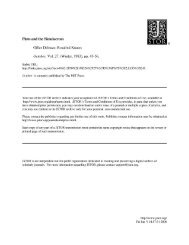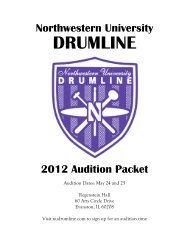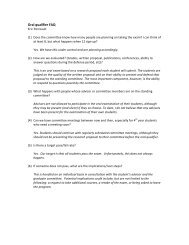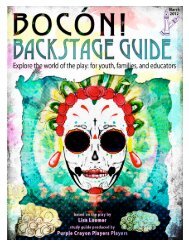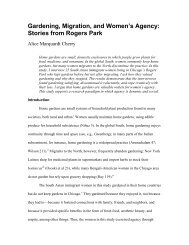research - Associated Student Government, Northwestern University
research - Associated Student Government, Northwestern University
research - Associated Student Government, Northwestern University
You also want an ePaper? Increase the reach of your titles
YUMPU automatically turns print PDFs into web optimized ePapers that Google loves.
RESEARCHwith community building. The gardeners have spentcommittee meetings, workdays, and special events interactingand learning about each other’s lifestyles, andthus have come to view each other as members of thecommunity rather than long-term residents, newcomers,or other category. Furthermore, their communalgardening style fosters equality and shared responsibility.DiscussionA physical garden space that supports communalgardening, such as in gardens B, D, and E, has greatercommunity-building capacity than an individual gardeningspace. This type of spatial construction increasesthe amount of social interaction among gardeners bypromoting cooperative planning, decision-making,and actions. Communal gardening also increases theamount of investment gardeners make by distributingwork responsibilities evenly, which ensures that allgardeners receive benefits, such as a share of the harvestand social relationships. In contrast, individual gardeningdevolves planning and decision-making to separateactors, eliminating the discussion, debate, and collaborationso essential to the development of a community.Each gardener can construct the physical space of herplot in whichever way she so chooses. As a result, theindividual gardener has the power to affect the communitywithout the input of its members and has the abilityto work separately during his own free time, possiblywithout ever interacting with his fellow gardeners.The effects of boundary delineation and control ona garden’s community-building capacity are less clear.Across all gardens, the dialogue about fences and lockspresented several concerns. One issue that appears to beresolved or diminished by a fence and lock is the presenceof undesirable behavior and material, including litterand drugs. In this respect, boundary protection cansignificantly improve the quality of garden space andcommunity. However, many gardeners feel the negativeimpact on the community far outweighs any benefit:high fences and locks present a physical and symbolicbarrier to individuals’ participation that directly contradictsthe community-oriented purpose of a “communitygarden”. Based on the evidence gathered, the negativeperceptions are stronger than positive ones. Therefore,boundary delineation and control slightly decrease agarden’s capacity to build community.A symbolic garden space that has multiple leadershiproles and more opportunities for gardeners’ investment,such as in gardens D and E, is more capable ofbuilding community than a garden with a single leaderand few investment opportunities. The former symbolicstructure enables more fluid and open communicationand interaction among gardeners. Organized workdaysand committee meetings are forums that offer an evenground on which to relate. These settings let gardenersVOLUME 7, 2011-2012set aside the political, economic, and social contextsthat usually codify their words and actions and insteadcommunicate within the garden space in a way that isless influenced by their social positions in the neighborhoodand more determined by their shared interest ingardening and the goals of the gardens. As a result, thedivisions that exist within the neighborhood are erodedin the garden space, thereby building the integratedcommunity that the gardeners would like.ConclusionEthnographic evidence from this study indicatesthat physical gardening style, leadership, and investmentopportunities play a significant role in a garden’s capacityto build community. Physical boundary delineationand control play a role to a slightly lesser extent. Acrossall of these physical and symbolic attributes, the morecollectivist the garden space, the greater its communitybuildingcapacity. Conversely, the more individualisticthe garden space, the lower its capacity. These resultshave impressive implications for new and existing urbangardens: they underscore the importance of spatialconstruction in a garden’s pursuit of its goals, especiallyif those include community building or the garden islocated within a neighborhood fraught with discord.Future <strong>research</strong> on this topic, and specifically on therole of gardeners’ social positions within the surroundingneighborhood (i.e. long-term resident, newcomer)on garden space and community, would benefit residentsand planners seeking to build community withinincreasingly diverse and complex urban environments.AcknowledgmentsI would like to thank my advisor, Timothy KeeseEarle, faculty mentor, Helen B. Schwartzman, andgraduate mentor, Jesse Mumm, for all of their direction,patience, and support throughout this entire process.Their wisdom and critique made the development ofmy <strong>research</strong> and analysis possible.ReferencesHarvey, David. 1973 Social Justice and the City. London, Edward Arnold.Kuo, Frances E, William C. Sullivan, Rebekah Levine Coley, and Liesette Brunson1998 “Fertile Ground for Community: Inner-City Neighborhood Common Spaces.” AmericanJournal of Community Psychology 26(6):823-51.Lefebvre, Henri. 1991 The Production of Space. Oxford, Blackwell.McMillan, David W. and David M. Chavis. 1986 “Sense of Community: A Definition andTheory.” Journal of Community Psychology 14:6-23.NORTHWESTERN UNDERGRADUATE RESEARCH JOURNAL45




